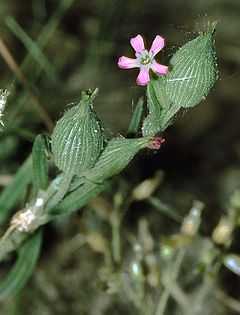Silene conica
From Wikipedia, the free encyclopedia
| Silene conica | |
|---|---|
 | |
| Silene conica | |
| Scientific classification | |
| Kingdom: | Plantae |
| (unranked): | Angiosperms |
| (unranked): | Eudicots |
| (unranked): | Core eudicots |
| Order: | Caryophyllales |
| Family: | Caryophyllaceae |
| Genus: | Silene |
| Species: | S. conica |
| Binomial name | |
| Silene conica L. | |
Silene conica is a species of flowering plant in the pink family known by the common name sand catchfly. It grows in dunes and sandy soils and is widespread in Europe and western Asia.[1] It has an annual life history and produces self-compatible hermaphroditic flowers and occasional male-sterile flowers (i.e., gynomonoecy). Like other members of Silene section Conoimorpha, S. conica is readily recognizable based on its bright pink petals and the prominent, parallel veins on its calyx.[2] In contrast to most flowering plants, S. conica appears to have a very rapid rate of mitochondrial mutation, and it is perhaps most notable for having the largest mitochondrial genome (11.3 Mb) ever identified.[3]
References
- ↑ Schischkin, B. K. 1970. Silene L. Pp. 442–528 in Flora of the USSR vol. 6, eds. V. L. Komarov and B. K. Schischkin. Jerusalem: Israel Program for Scientific Translation.
- ↑ Rautenberg A, Sloan DB, Aldén V, Oxelman B (2012) Phylogenetic relationships of Silene multinervia and Silene section Conoimorpha (Caryophyllaceae). Syst. Bot. 37: 226–237. doi: 10.1600/036364412x616792.
- ↑ Sloan DB, Alverson AJ, Chuckalovcak JP, Wu M, McCauley DE, et al. (2012) Rapid evolution of enormous, multichromosomal genomes in flowering plant mitochondria with exceptionally high mutation rates. PLoS Biol 10: e1001241. doi: 10.1371/journal.pbio.1001241.
This article is issued from Wikipedia. The text is available under the Creative Commons Attribution/Share Alike; additional terms may apply for the media files.